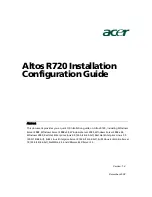
Optimized for virtualization and database applications with maximum
memory and compute capacity in a blade
Please see the Legal Information section for important notices and information.
1.
Product Guide
October 2010
IBM BladeCenter HX5
Product Overview
CONTENTS
Product Overview
1
Selling Features
2
Key Features
5
Key Options
13
HX5 Images
15
HX5 Specifications
16
The Bottom Line
18
Server Comparison
20
For More Information
21
Legal Information
21
Scalable 2-to-4-socket blade server optimized for
virtualization/consolidation, database, and ERP
Suggested uses:
Front-end and mid-tier applications requiring high performance (CPU, memory
or I/O), enterprise-class availability, and extreme flexibility and power efficiency.
IBM
®
has been designing and implementing chipsets under the X-Architecture
®
name since
2001. eX5 technology represents the fifth generation of products based on the same design
principle IBM began with in 1997: to offer Intel
®
Xeon
®
processor-based systems that are
expandable, offer “big iron” reliability, availability, and serviceability (RAS) features, with
extremely competitive price/performance.
The eX5 technology is primarily designed around three major workloads: database servers,
server consolidation using virtualization services, and Enterprise Resource Planning (application
and database) servers.
If you’re using industry-standard servers to run business critical applications, the systems that
run these applications need the type of technology designed into IBM’s eX5 technology systems.
The eX5 chipset represents a $100M+ investment in designing a flagship offering that can
harness the power of 4-socket-and-up 64-bit x86 (x64) Xeon processors. The eX5 family
includes a scalable performance
blade server
with the ability to scale from a
single-wide blade
(30mm) to a
double-wide blade
(60mm). Maybe you’d like to start out with a 2-socket blade and
possibly add sockets later, if your needs change. Or perhaps you need more than a 2-socket
blade, but don’t want to get locked into a monolithic 4-socket blade—again, in case your
requirements change. With IBM, you can start at 2 sockets and grow to 4 if needed. And if you
require a variety of 2- and 4-socket servers in your data center, you only have to qualify one
server for all these workloads. This can save much time and effort and speed deployment. You
can also save money on software licensing by virtualizing a 4-processor server into many VMs,
rather than using multiple 2-processor servers. Huge amounts of memory also enable more or
larger VMs, and larger databases (especially databases stored entirely in memory).
Reducing an entire server into a little over
.5U
of rack space (i.e., up to 14 servers in 9U) does
not
mean trading away features and capabilities for smaller size. The
IBM BladeCenter
®
HX5
blade server offers features comparable to many 1U rack-optimized full-featured servers, and
then some: The HX5 supports up to
two
of the latest high-performance
8-core, 6-core
, or
4-core
Intel Xeon
7500
and
6500
Series processors. The Xeon processors are designed with up to
24MB
of shared cache and leading-edge memory performance (up to
1066MHz
using
MAX5
,
depending on processor model) to help provide the computing power you require to match your
business needs and growth. In addition, the HX5 supports up to
128B
of
registered
double data
rate III (
DDR3
)
ECC
(Error Checking and Correcting) memory in
16
DIMM
slots, with multiple
levels of IBM Active Memory™ protection, for the highest levels of performance and availability.
Active Memory protection includes IBM
Memory ProteXion
™
, IBM
Chipkill
™
memory,
memory
scrubbing
,
memory rank sparing
, and
memory mirroring
.
Because business requirements change and a 2-socket server that meets those needs today
may not meet them in the future, the HX5 was designed to be upgradeable to meet the diverse
needs of multiple workloads. For
compute-intensive workloads
, it can be configured as a 2-
wide blade server with up to
4 processors / 32 cores
,
32 DIMMs
(
256GB
),
4 PCIe cards
,
16 I/O
ports
, and
4 solid-state drives
(
SSDs
). Conversely, for
memory-intensive workloads
, the
HX5 can be configured as a 2-wide server consisting of
1 blade server
and
1
MAX5
memory
expansion blades, with up to
40 DIMMs
(
320GB
). IBM
FlexNode partitioning
allows a physical
4-socket configuration to be remotely reconfigured by software into
two
logical 2-socket servers,
as needs change or for daily peak and off-peak workloads.
The HX5 supports
VMware vSphere Hypervisor
(formerly ESXi)
preloaded
on a standard USB
flash drive. It operates in a diskless configuration, offers a smaller memory footprint, extremely
high performance, and stronger security, making getting a system up and running in a virtualized
environment faster and easier than ever before.
IBM’s eX5 technology-based systems are the ideal solution for scale-up database-serving
applications on Microsoft
®
Windows
®
with Microsoft SQL Server
®
or IBM DB2
®
, as well as Linux
®


































